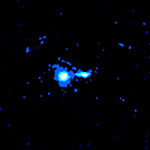August 23, 1999
NOTE TO EDITORS: N99-47
The first images from the world's most powerful X-ray telescope, NASA's Chandra X-ray Observatory, will be unveiled at a media briefing at 1 p.m. EDT, Thursday, Aug. 26. The briefing will be held in the James E. Webb Auditorium at NASA Headquarters, 300 E St. SW, Washington, DC. The images include the spectacular remnants of a supernova and other astronomical objects.
Panelists will be:
- Dr. Edward Weiler, Associate Administrator for Space Science, NASA
Headquarters, Washington, DC;
- Dr. Harvey Tananbaum, Director of the Smithsonian Astrophysical
Observatory's Chandra X-ray Center, Cambridge, MA;
- Dr. Martin Weisskopf, NASA's Chandra Project Scientist, NASA's
Marshall Space Flight Center, Huntsville, AL; and
- Dr. Robert Kirshner, astrophysicist, Harvard University,
Cambridge, MA.
The event will be carried live on NASA Television with question-and-answer capability for reporters covering the briefing from participating NASA centers and from the Chandra Operations Control Center in Cambridge. NASA Television is available on transponder 9C, satellite GE-2 at 85 degrees West longitude, vertical polarization, frequency 3880 MHz, audio of 6.8 MHz.
Chandra has been undergoing activation and checkout since it was placed into orbit during Space Shuttle mission STS-93 in July. Chandra will examine exploding stars, black holes, colliding galaxies and other high-energy cosmic phenomena to help scientists gain a better understanding of the structure and evolution of the universe.
Chandra images and additional information will be available following the briefing on the Internet at:
NASA press releases and other information are available automatically by sending an Internet electronic mail message to domo@hq.nasa.gov. In the body of the message (not the subject line) users should type the words "subscribe press-release" (no quotes). The system will reply with a confirmation via E-mail of each subscription. A second automatic message will include additional information on the service. NASA releases also are available via CompuServe using the command GO NASA. To unsubscribe from this mailing list, address an E-mail message to domo@hq.nasa.gov, leave the subject blank, and type only "unsubscribe press-release" (no quotes) in the body of the message.
NASA TV on the web
MEDIA CONTACTS
Donald Savage
Headquarters, Washington, DC
(Phone: 202/358-1547)
Dave Drachlis
Marshall Space Flight Center, Huntsville, AL
(Phone: 256/544-0034)
Wallace Tucker
Chandra X-ray Observatory Center
(Phone: 617/496-7998)



